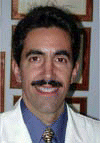That was full data from all 10 patients. But if we look at the 10 patients individually, one by one, nine of the 10 patients recapitulated the overall trend-which is that the nose was significantly more congested in REM sleep and less congested in non-REM sleep, he said.
Explore This Issue
August 2008The finding was different from what the researchers had anticipated. REM sleep is characterized by profound sympathetic activation throughout the body. And this goes along with profound vasoconstriction throughout the body, he said. One would expect a decrease in congestion, or shrinkage of the turbinates.
During REM sleep, there are three parts of the body that are preferentially perfused with blood: the kidneys, the mesenteric vasculature, and the brain. As a hypothesis of what is happening in the nose, we think that our results are best explained by increased carotid blood flow, and a concominant increase in blood flow to the ethmoidal arteries, which increases congestion in the nose during REM sleep as a side effect of increasing perfusion to the brain during REM sleep, Dr. Morris said.
This was a pilot study, however, and more research should be done to confirm the findings, and why increased congestion may be occurring, he said.
Pharmacologically Active Middle Meatal (MM) Stents
Also at the ARS session, attendees heard the latest about pharmacologically active middle meatal (MM) stents. Peter J. Catalano, MD, Chairman of the Department of Otolaryngology at the Lahey Clinic in Burlington, MA, described findings from a study investigating whether the stents provide benefit in patients undergoing endoscopic sinus surgery (ESS), and whether they are good carriers for local drug delivery.
This is the first study ever to evaluate middle meatal spaces for possible local drug delivery after endoscopic sinus surgery. We also introduced a new synthetic resorbable spacer that has been shown to be biologically inert, he said.
The study was designed to have three phases. Phase 1 was to evaluate the new synthetic middle meatal spacer, Nasopore®, and compare it to MeroGel. The latter has been shown to be biocompatible and biologically inert, Dr. Catalano said.
 This is the first study ever to evaluate middle meatal spaces for possible local drug delivery after endoscopic sinus surgery. We also introduced a new synthetic resorbable spacer that has been shown to be biologically inert.
This is the first study ever to evaluate middle meatal spaces for possible local drug delivery after endoscopic sinus surgery. We also introduced a new synthetic resorbable spacer that has been shown to be biologically inert.-Peter J. Catalano, MD
Phases 2 and 3 evaluated Nasopore, a bioresorbable, compressive foam, as a drug delivery technology in patients undergoing ESS. It comes in several different shapes. And you could cut it to any shape you want, he said.
Leave a Reply